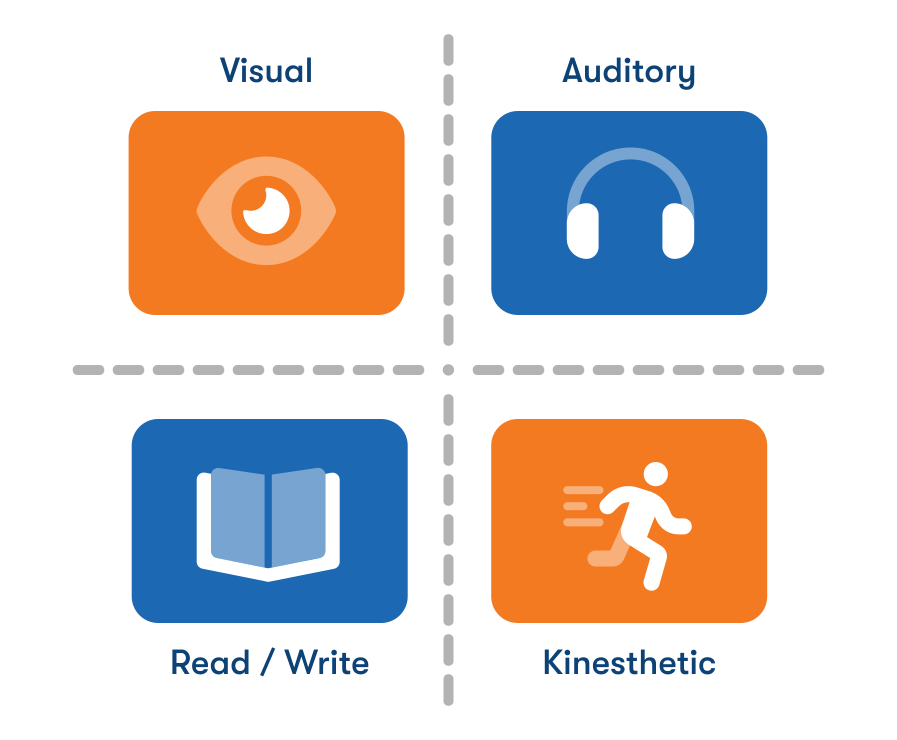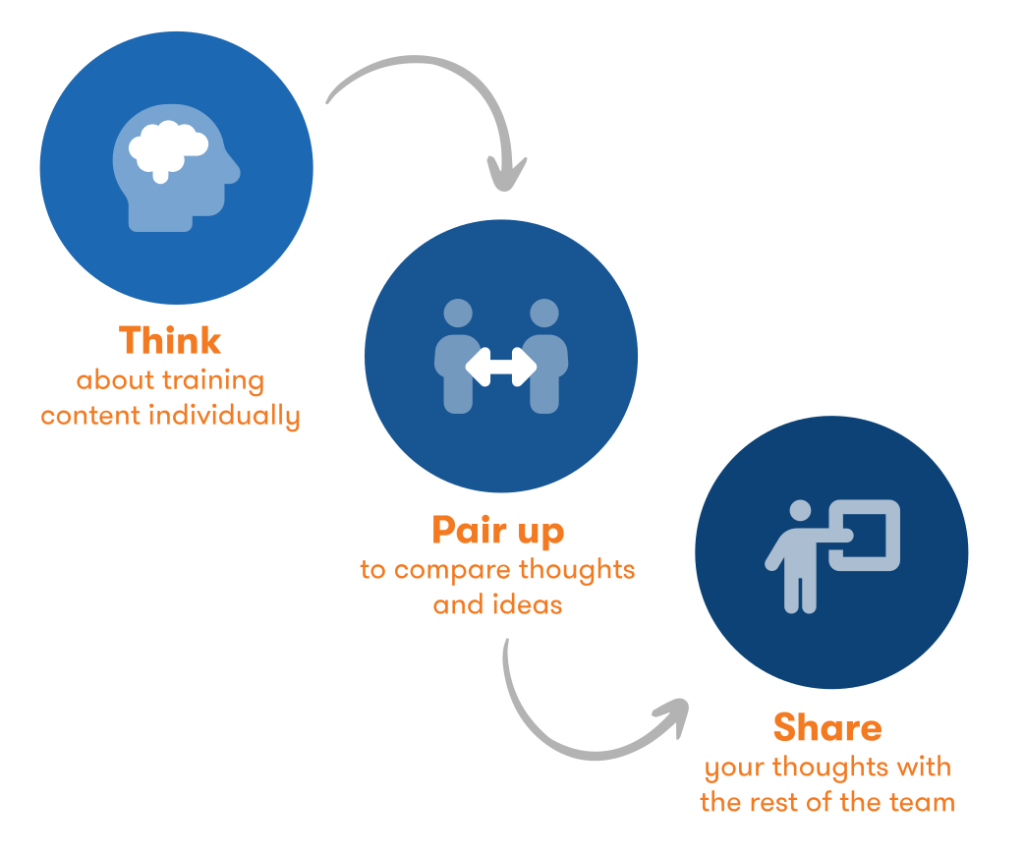Everyone’s brain receives and processes information differently. This is the reason for different learning styles. While some people can easily understand a concept when you explain it out loud to them, others may need you to physically draw it out for them and use examples.
Because people learn differently, failing to adapt and diversify your training material to accommodate different learning styles will leave your employees, and by extension your company, at a disadvantage.
So, how can you appeal to the multiple learning styles and ensure everyone gets the most out of their training?
The solution is multimodal learning.
What exactly is multimodal learning, and how can you implement it? Let’s dive in.
What is multimodal learning?
Multimodal learning means using and combining different modes (visual, auditory, reading, and kinesthetic) when teaching a concept so as to accommodate multiple learning styles.
A “mode” is anything that communicates meaning somehow. Examples of modes used in training are:
- Speech
- Audio
- Text
- Pictures
- Illustrations
- Video
- Music
- Gestures
- Facial expressions
“Learning styles” refer to how people prefer to learn, or how they learn best.
What is a multimodal learning strategy?
A multimodal learning strategy is a method of teaching that involves using different modes (mediums of communication) to deliver the learning material.
The purpose of using a multimodal learning strategy is to improve teaching quality by matching your content delivery with each trainee’s preferred mode of learning. In this way a multimodal learning approach contains elements that appeal to every learning style and ensures maximum understanding for everyone on the team.
The first step in successfully implementing multimodal learning is understanding the different learning styles.
What are the different learning styles?
There are different models that seek to explain learning styles, but the most widely recognized is the VARK model. The VARK model groups learning styles into four categories – Visual, Auditory, Reading/ Writing, and Kinesthetic.

- Visual learners: These are people who learn best by seeing and responding to visual cues. They easily understand concepts delivered using images, diagrams, graphs, charts, color-coded information, and other visual elements.
- Auditory learners: These people learn best by hearing and responding to auditory cues. They easily understand information delivered via verbal instruction, discussions, songs, podcasts, etc.
- Reading/ writing learners: These people learn best by reading and responding to written cues. They easily understand text-based information in books, PDFs, lecture notes, etc. Writing (note taking) while taking in the textual information reinforces the information for these learners.
- Kinesthetic learners. These are people who learn best by doing and responding to tactile cues. They easily understand information delivered via physical movements and actions. Demonstrations and hands-on practice are good examples of kinesthetic learning.
It’s important to keep in mind that people don’t always fall into just one of these groups. Most people learn best using a mix of two or more of these learning styles. These are multimodal learners.
Benefits of multimodal learning
Using multimodal learning to teach concepts and deliver training has many benefits including:
Engaging everyone in the learning process
Every training group will have different types of learners. When you choose to train using one mode, you risk alienating employees who have a harder time understanding the concepts that are presented in that particular mode.
By employing a multimodal learning approach you’re helping to include and engage every team member in the learning process.
Moreover, multimodal learning strategies use elements that make training more fun and interesting. For example, using stories and real-life examples brings training sessions to life and hands-on demonstrations get employees directly involved.
Helping employees retain information better
It may seem obvious, but it’s worth stating that employees are more likely to remember their training when they fully understand it. So, multimodal learning automatically aids retention by facilitating understanding.
Multimodal learning strategies also aid retention through associative memory. Associating a concept from their training with a particular stimulus or result makes them much more likely to be able to recall it later.
Familiarizing employees with the complexity of on-the-job interactions
Chances are that your employees’ jobs don’t involve only listening, or watching, or reading, or physical activity. It’s a combination of all of these, all the time.
By presenting training though different modes you make the experience much more realistic.
Developing learners’ skills in all modes
When you deliver content to unimodal learners using only their particular learning style, they will struggle with understanding concepts delivered using other modes.
When you combine the various ways people learn, each person receives some information in their preferred mode, while also seeing how the different modes connect. This increases their skill in less-preferred modes and better prepares them for real-life challenges.
What is an example of a multimodal learning style?
Now that we’ve understood what multimodal learning is and why it’s beneficial, let’s explore an example of how to employ it in your organization.
Let’s use an example that is applicable to the hospitality industry— a manager may be interested in training new hires on how to properly check in guests at a hotel. Here’s how you can accomplish this using all four learning styles of the VARK model:
First explain to your new hires the process of checking in a guest out loud. Next, demonstrate those steps with another team member acting as the guest while your trainees observe the process that you just verbally described. Then, have each new hire physically go through this process themselves, checking in another team member who is acting as the guest, and following the steps from greeting, checking out and processing payment. Finally, provide each employee with a written guide of these steps. Ideally you’ll share it with them in a mobile-first format that is designed to be read and accessed from their phone, allowing them to reference back to it any time they need.
In this example we have incorporated all four learning styles of the VARK model. That may not always be possible with every training topic you need to cover, so a good rule of thumb is to try to employ at least two of them in your training initiatives.
Create multimodal courses and share them directly to your team’s smartphones

How to implement multimodal learning
The following strategies will help you create a multimodal learning environment to improve teaching quality and learning outcomes.
Add different media to training programs
For office-bound employees, training is often delivered through the use of an LMS for people to complete from their laptops. If this is the case for your company, consider mixing up the different media that is included in your courses so that it doesn’t include only PDFs or written assessments. Adding video and audio files to your courses will help engage all types of learners.
For deskless employees, training is often hands-on and conducted in person. This makes sense given the nature of these jobs, but it doesn’t have to stop here. You can help improve the experience for your employees who may be visual or read/write learners by providing reinforcement training material in the form of instructional videos, and written guides that they can reference back to as needed.
Use blended learning techniques
In addition to in-person training you can also conduct group training sessions online. This is a valuable option for companies with distributed workforces where getting everyone together for an in-person event is costly.
In a digital learning environment, you can have live discussions with trainees, post extra learning materials, assign tasks, and more, making it easier to manage the group.
Offer multimodal assignments
It’s often the case that employee assessments are conducted on paper or are completed online. You can adopt a multimodal assessment strategy by asking employees to physically carry out the task in front of you while you evaluate them, or ask them to answer questions through an oral exam.
Multimodal learning activities
These activities can help you create a multimodal learning environment without knowing it.
Case-based learning
Cite actual cases when teaching concepts. The real-life examples prove that what you teach in sessions is useful in the real world. They also make sessions more interesting and make trainees remember content longer.
Gamified assessments
When creating assessments and quizzes for your employees you can use a mix of question types to accommodate the different learning styles. For example, some of your questions might be open ended, others can require employees to sort the steps of a process in the correct order, and others to match images to their corresponding descriptions.
Think-pair-share strategy

Promote collaboration and encourage the expression of ideas.
Using the think-pair-share strategy, you encourage employees to:
- Think – take time to think about the content individually.
- Pair – pair up with other team members to compare thoughts and ideas
- Share – present their thoughts to the rest of the team
FAQs
How do multimodal learners learn best?
Multimodal learners learn best when content is delivered using the four different modalities (visual, auditory, read/write, and kinesthetic). This type of instruction engages multiple senses at the same time, making it more likely for learners to internalize and remember the information in the future.
The key to multimodal learning— matching your training with the right delivery method
It may feel like a challenge to transform every training initiative and program in your company to be multimodal in nature, and the truth is, you don’t have to. It’s important to keep in mind that each training topic probably lends itself naturally to a particular method of delivery.
For complicated processes, step by step guides and instructional videos are an ideal delivery method. For customer facing roles, auditory learning resources are a natural fit. And for physical jobs that need to be carried out, a kinesthetic learning approach will be most effective.
Key takeaways
- People have different learning styles, so providing training in only one format has a high risk of being ineffective for a large portion of your employees.
- Multimodal learning involves using different modes when training, ensuring that every employee receives content in a format that accommodates their learning style.
- Adopting a multimodal learning strategy increases the effectiveness of your training initiatives as it makes it more likely that employees will understand and retain that information.
- Some ways to implement multimodal learning include adding different media to training programs, using a mix of online and in-person training, and assessing employees in different formats depending on the training topic.


